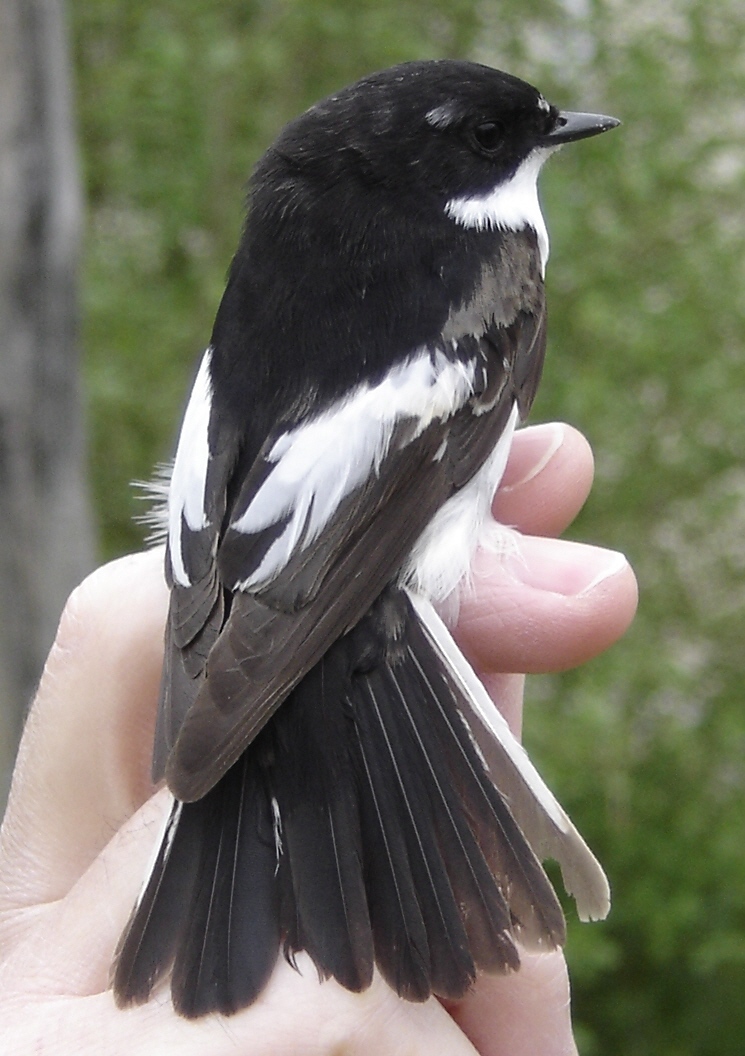- European Pied Flycatcher
Taxobox
name = Pied Flycatcher
status = LC | status_system = IUCN3.1

image_width = 204px
image_caption = Adult male
regnum =Animal ia
phylum = Chordata
classis = Aves
ordo =Passeriformes
familia =Muscicapidae
genus = "Ficedula "
species = "F. hypoleuca"
binomial = "Ficedula hypoleuca"
binomial_authority = (Pallas,1764 )The Pied Flycatcher, " Ficedula hypoleuca", is a small
passerine bird in theOld World flycatcher family, one of the fourspecies ofWestern Palearctic black-and-white flycatchers . It breeds in most ofEurope and westernAsia . It is migratory, wintering mainly in westernAfrica .This is a 12-13.5 cm long bird. The breeding male is mainly black above and white below, with a large white wing patch, white tail sides and a small forehead patch. The Iberian
subspecies "iberiae" (known as Iberian Pied Flycatcher) has a larger forehead patch and a pale rump. Non-breeding males, females and juveniles have the black replaced by a pale brown, and may be very difficult to distinguish from other "Ficedula" flycatchers, particularly theCollared Flycatcher , with which this species hybridizes to a limited extent (Parkin 2003).The bill is black, and has the broad but pointed shape typical of aerial insectivores. As well as taking insects in flight, this species hunts
caterpillar s amongst the oak foliage, and will take berries. It is therefore a much earlier spring migrant than the more aerialSpotted Flycatcher , and its loud rhythmic and melodious song is characteristic of oak woods in spring.They are birds of deciduous woodlands, parks and gardens, with a preference for
oak trees. They build an open nest in a tree hole, and will readily adapt to an open-fronted nest box. 4-10 eggs are laid.The very similar
Atlas Flycatcher ("Ficedula speculigera"), of the mountains of north westAfrica was formerly classed as subspecies of the Pied Flycatcher.References
* Database entry includes justification for why this species is of least concern
* Parkin, David T. (2003): Birding and DNA: species for the new millennium. "Bird Study" 50(3): 223–242. [http://www.ingentaconnect.com/content/bto/bird/2003/00000050/00000003/art00003 HTML abstract]
External links
* [http://www.ibercajalav.net/img/387_PiedFlycatcherFhypoleuca.pdf Ageing and sexing (PDF) by Javier Blasco-Zumeta]
* [http://www.bsc-eoc.org/avibase/species.jsp?lang=EN&id=97F9C53ACF6FEF18&ts=1220606924050&sec=summary Avibase]
* [http://www.oiseaux.net/birds/photos/pied.flycatcher.html Oiseaux] Images.
Wikimedia Foundation. 2010.
